Non-Confidential Research Projects
In addition to undertaking consultancy projects, Wildlife Marine actively conducts independent research into environmental issues of interest. The results of these projects are widely promoted, and result in scientific papers, presentations, documentaries, interviews, and reports. A brief overview of some of these projects is listed below, however this list is not exhaustive as many project announcements are held off due to publication and collaboration restrictions.
For further images and to keep up to date with our latest non-confidential outputs and comments, please also follow the Wildlife Marine Twitter and Facebook social media pages (see a preview of our latest tweets to the right).
Please note, although we receive many requests, due to OH&S and confidentiality reasons, we regretably cannot take on interns or volunteers for our projects
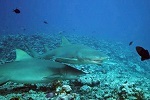
eDNA and shark detection
In a world first, Wildlife Marine has collaborated with a group of very talented researchers from around the globe to demonstrate that shark presense can be identified from the DNA fragments they leave in the water as they pass. This method of identifying where species occurs is much quicker and cheaper than contemporary methods, and also detects individuals who are shy or people-negative. The possibilities for this method detecting rare and cryptic species is also enormous. Our paper on shark forensics can be found here.

Demographic traits of parrotfish
Wildlife Marine's Dr William Robbins helped survey dichromatic parrotfishes across the northern Great Barrier Reef to examine the degree to which variation in body size distributions and size at sex change are affected by directional influence from biotic and abiotic factors. Our work with Dr Brett Taylor clearly demonstrates how wave exposure influences herbivore demography, and how ecosystem processess must be understood to understand underlying fish life-histories. This work has been published, and can be read here.

Herbivorous fish nutritional ecology
Determining exactly what coral reef herbivores eat is only part of understanding their functional role. Wildlife Marine helped with an exciting fieldtrip to Lizard Island where we helped determine the in-depth nutritional processes, and functional ecology of parrotfish and surgeonfish on the Great Barrier Reef. We know these species play important roles on coral reefs, and helping unravel their individual processes will better help with our understanding of the importance of herbivorous bottom-up coral reef processes.

Moving potentially dangerous sharks
Wildlife Marine's Dr William Robbins led an amazing team examining Dr Fabio Hazin's method of catching and relocating coastal sharks. Moving sharks offshore in a pool on a boat doesn't harm the shark, and while Fabio's program was running it reduced shark incident rates by around 97% in Recife, Brazil. This method has never been tried outside Brazil, and Will wanted to see if it could provide a non-lethal alternative to reduce public risk in Australia. Will's investigation formed the basis of the documentary Shark Exile, which aired on Discovery's Shark Week 2017.
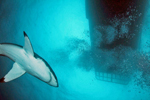
Monitoring white shark tourism
Eco-tourism is an ever-expanding global industry, and while there's many benefits to getting people to experience and learn more about large marine animals, there's always a risk of negative impacts to the species. Wildlife Marine co-supervised a Flinders University honours student project assessing the pros and cons of different cage diving industry methods to monitor white shark in South Australia. The project had the industry's support and assistance, and has resulted in a great publication which you can read here.

Spencer Gulf risk assessment
Together with Dr Charlie Huveneers, Wildlife Marine's Dr William Robbins led the development and implementation of a published anthropogenic risk assessment on threatened, endangered, protected and iconic marine-associated species in Spencer Gulf (South Australia). Based out of Flinders University, this large-scale project examined 27 different threats against 38 species of cetaceans, pinnipeds, sharks, seabirds, fish and invertebrates. Its findings will help shape future developments and determine research priorities in the region.

Supporting tissue sharing
Wildlife Marine is now an officical Research Ally of Otlet. These guys are an international company developing a novel online database linking scientists who have, or are seeking tissue samples around the world. It's a great idea, and one which can easily maximize the amount of data derived from individual animals. This makes it a great concept from both ecological and researcher viewpoints. Wildlife Marine is very happy to support these guys, so check out their website, and see if there's samples you can contribute or use!

Documenting coral reef dynamics
Once again in collaboration with our friends at the Khaled bin Sultan Living Oceans Foundation, Wildlife Marine's research has been the focus of a documentary detailing the interactions and vulnerabilities of tropical coral reefs. The film will be released soon, allowing us to showcase the science which lets us tease out the behaviours and responses of large mesopredators to both human-induced and natural environmental factors. With coral reefs under increasing pressure, determining their likely responses is becoming increasingly more important.

Using science to make a difference
We undertake alot of science here at Wildlife Marine. However, conducting science for science's sake is irresponsible, and a waste of time and resources. Wildlife Marine strongly promotes getting the most out of what it does, and we now give a university lecture on how research can be used to make a difference outside scientific circles. We discuss how our research has direct improved management and sustainability by changing State laws, modifiying Government policies, and teaching the public through out documentary work.

Whiting age and demography research
In collaboration with leading Australian fisheries biologists, Wildlife Marine helped unravel the biology of eastern Australian whiting. Our cutting-edge work on whiting growth assists in the long-term sustainable management of these commercially-important stocks. Our consortium has now produced peer-reviewed scientific publications on general whiting ecology, and specific papers on school whiting demography and stout whiting demography.

Unravelling coral reef processes
Coral reefs are complex and dynamic environments. With literally hundreds of species involved in thousands of interactions, predicting the likely abundances of species, and determining the factors influencing them is a very involved process. Wildlife Marine is part of a multi-organisational collaboration working on unravelling these intricacies, and helping illuminate some of the processes driving coral reef ecosystems. These findings also let us investigate how peoples' use of coral reefs impacts these processes. See here for our collaborative research publication!

International fish management workshop
Wildlife Marine was invited by our Flinders University colleague, Dr Charlie Huveneers, to co-host a week-long international fisheries course for visiting Indian fisheries managers. Our course discussed the management of multiple fish, shark and invertebrate fisheries, and involved us preparing and delivering a series of lectures, practicals and tutorials at a senior manager level. We provided and discussed many examples based on our experiences in South Australia, Queensland, New South Wales and Western Australia.

Minimizing human-shark interactions
Minimizing the likelihood of shark interactions is one of the goals of governments, lifesavers and the beach-going public. The fewer interactions between these two groups means less harm to people, sharks and the environment. The New Caledonia Southern Province has shown great forethought with its rapid and proactive response to developing a range of complementary non-lethal initiatives to minimize shark risk at its beaches, and Wildlife Marine is pleased to be advising them on the development and implementation of these programs.

Shark movements on coral reefs
Wildlife Marine continues its highly successful collaboration with the international APEX consortium of researchers. With multiple fieldtrips completed, keen postgraduate students, and literally millions of shark detections, this project allows us to determine coral reef shark movements around the New Caledonian coast and remote atolls. Already our data has revealed some very exciting grey reef shark and silvertip shark behaviours, and we're now looking "behind the scenes" to unravel what environmental and anthropogenic factors drive these patterns.

White shark dynamics
Wildlife Marine is proud to announce our latest honours student, Ms Leila Nazimi (Flinders University), received a well-deserved first class honours for her research into the long-term population dynamics and residency of white sharks at the Neptune Islands Marine Park (South Australia). Leila identified shark individuals through photographic and cage operator records, and characterised the social structure and behaviours of individuals using the area. Her work provides recommendations into the future monitoring of these populations.

Reef shark feeding behaviour
Thanks to the support of the Khaled bin Sultan Living Oceans Foundation, Wildlife Marine conducted a series of highly successful field trips examining shark and fish behaviours and interactions on French Polynesian coral reefs. Our ground-breaking research identified and quantified previously-undocumented behaviours of reef sharks feeding in the wild. This work was the focus of the Emmy award-winning documentary Sharks of the Coral Canyon, with the results published in the internationally peer-reviewed Coral Reefs journal.

White shark movements
Wildlife Marine collaborated with researchers from the Rodney Fox Research Foundation and the CSIRO to examine white shark movements at multiple locations in South Australia. Our project involved acoustically tagging white sharks, deploying and retrieving VR2W underwater listening stations, and analyzing large amounts of data to catagorise individual movement patterns. This work has identified a likely second South Australian white shark aggregation area, and been published as an open-access scientific paper.

Support of Shark Share Global
Wildlife Marine is now a Research Ally of Shark Share Global. These guys are an international foundation developing a novel online database linking scientists seeking shark tissue samples around the world. It's a great idea, and one which can easily maximize the information taken from individual sharks. Wildlife Marine is glad to support these guys, so check out their website, and contribute to the cause if you can.

Reef fish specialization
Following from his previous fish research at James Cook University, Wildlife Marine founder, Dr William Robbins assisted Dr Simon Brandl in his examination of surgeonfish ecological specializations on tropical coral reefs. The study specifically quantified the relationships between surgeonfish morphological and behavioral adaptations across several ecological niche axes. Simon did a fantastic job, and produced an exciting paradigm-questioning paper published by the Royal Society of London.
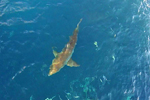
Remote aerial shark detection
For many years now, Wildlife Marine has vocally supported research into the use of unmanned aerial vehicles to detect and identify large sharks in coastal waters. Such detections could provide a cost-effective early warning system for the general public, and eliminate the current use of shark nets and drums. Wildlife Marine is very excited that Australian trials are underway using commercially-available systems such as the DJI phantom, available from Sydney-based Rise Above Aerials.
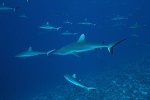
Grey reef shark population structure
Wildlife Marine has co-authored important research into the genetic connectivity and selection of Indo-Pacific grey reef shark populations. The project first identified the spatial patterns of shark population structure, then applied multiple genetic models to determine the levels of migration occurring to produce these patterns. It then looked at what is driving genetic selection. The findings of this study are essential for the sustainable management of this important mesopredator, and have been published as high-profile connectivity and selection papers.

Turtle tagging and monitoring
Wildlife Marine founder, Dr William Robbins spent many months investigating turtle biology in Port Hedland, NW Western Australia. Working for Care for Hedland Environmental Association Inc., Will was responsible for the tagging, monitoring and data analysis of all females nesting on Cemetery Beach. Flatback turtles, the primary species at Port Hedland, only nest in Australia, and with little known about the status of this population, this data will aid their effective management and long term survival.

Investigating fisheries management strategies
Once again Wildlife Marine teamed up again with the Living Oceans Foundation to further investigations into coral reef dynamics. Using a combination of underwater visual censuses and stereo cameras we quantified large predator and herbivore densities managed under different fishing regimes (i.e. no entry, no take and open to fishing zones) on the Great Barrier Reef. This research allowed us to determine the effectiveness of long-term fisheries management, and see how management affects different ecological groups.

Species at the intersection
Together with Dr Charlie Huveneers from Flinders University, Wildlife Marine co-authored its first book chapter. Entitled Species at the intersection, we examined the potential effects of commercial and recreational fisheries against wildlife tourism across a range of shark and ray species. We also explored the various management regulations employed by different countries, contrasting their economic status against the role which their wildlife tourism plays.
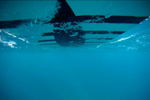
Shark mitigation technology
Wildlife Marine's Dr William Robbins was invited to assist the University of Western Australia with their trials of shark mitigation technologies. Will contributed his extensive practical knowledge of field-based shark research, and ended up running one of the five studies being undertaken. This fieldwork constituted the initial trials of the UWA shark program, and will lead to an expanded program investigating ways to potentially reduce shark incident rates in Australia and overseas.

Grey reef shark behaviours around humans
Wildlife Marine's first honours student completed his project quantifying the interactions of grey reef sharks with divers on coral reefs. This project remotely assessed shark behaviours through underwater cameras, and directly assessed the effects which humans have on reef shark behaviours and local abundances. The finding from this research will directly contribute to our understanding and management of sharks on coral reef ecosystems. The initial publication has already been published in Coral Reefs.

Aerial shark sighting assessment
Wildlife Marine's Dr William Robbins led a ground-breaking study which determined the efficacy of aerial beach patrols to detect large (2.5 m) sharks at beaches. This work was conducted while at Cronulla Fisheries Research Centre of Excellence, with follow-up analysis and writing through Wildlife Marine. The findings are quite damning, and have received considerable press, including the front page of the Sydney Morning Herald. The Government report can be downloaded here or the full peer-reviewed publication here.

Grey reef shark microsatellites
Wildlife Marine's Dr William Robbins contributed over 150 tissue samples from the Great Barrier Reef, Coral Sea and Indian Ocean in a project characterising polymorphic microsatellite loci in grey reef sharks. Led by Paolo Momigliano of Macquarie University, this is the first step in a bigger study to determine grey reef shark population structure and connectivity to aid future management. The loci identified also cross-amplified in other whaler shark species, allowing their future use across these species too. Check out our scientific paper for more details.

Grey nurse shark research published
Dr Will Robbins led a comprehensive investigation of wild grey nurse shark (sand tiger) interactions with common recreational fishing gears. This work was conducted while at Cronulla Fisheries Research Centre of Excellence, with follow-up analysis and publishing through Wildlife Marine. This research was directly responsible for the positive legislative changes to NSW Critical Habitats in September 2012. The resulting scientific paper is open-access, meaning anyone can download it from Endangered Species Research

Teaching fisheries science
Wildlife Marine has
once again presented a series of lectures and practicals to third year university students at Flinders and Curtin Universities. The topics covered included the background, implementation and specifics of fisheries stock models, with examples taken from fish and shark fisheries. The lectures and practicals devised by Wildlife Marine were well received, and will aid students in their understanding of the synergies between science, stakeholders and management.
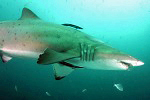
National shark sustainability workshop
Wildlife Marine was happy to travel to Hobart to help determine conservation priorities and sustainable harvest strategies for Australian sharks and rays. This federally-funded workshop brought together the major scientists and managers from around the country to balance conservation with resource use. Wildlife Marine led discussions on the state of knowledge of species such as the grey nurse shark, Carcharias taurus.

Sony support of shark research
Wildlife Marine has just received sponsorship of its shark projects by Sony Australia. We are extremely grateful to Sony for their generosity, and look forward to employing their cameras to further our research program. To check out what we'll be using, go to www.sony.com.au/actioncam

Bonito fish growth
Bonito are an important commercial fish species in Eastern Australia. Wildlife
Marine has collaborated with researchers from the Cronulla Fisheries Research Centre (New South Wales Primary Industries) to calculate the growth rate and longevity of Eastern Australian bonito stocks. This work is the first to use a novel set of comparative techniques and is now published in Marine and Freshwater Research

Associate with IC Independent Consulting
Wildlife Marine has become a collaborate associate with IC Independent Consulting. IC Independent Consulting is an exciting new firm with expert experience in institutional governance, and a particular focus on science, policy and regulation. This collaborative association will expand the expertise base of both organisations, and continue the successful research collaborations which Wildlife Marine has with ICIC's founding partner, Prof. Steve Kennelly.

International shark management workshop
Wildlife Marine is proud to have hosted a week-long shark
management course for the Environment Agency of Abu Dhabi, United Arab
Emirates. This international workshop taught participants the practical and
theoretical skills to assess and manage their national shark fisheries. A wide
variety of fisheries and demographic fundamentals were explored in detail, with
emphasis given to both practical and theoretical training and
interpretation.

Whitetip reef shark genetics
The stock structure of whitetip reef shark populations has
just been genetically determined across the tropical Indo-Pacific. Wildlife
Marine's collaboration with
researchers from the University of Hawaii has established the level of
both small- and large-scale connectivity in whitetip reef shark populations, and
has proposed an answer to the riddle of how the most sedentary of the whaler sharks
is also the most widespread. This work is now available from the Journal of Biogeography
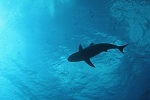
Australian shark management review
Wildlife Marine was invited by one of Australia's fisheries agencies to conduct an independent review of its shark management strategy. The review examined their report detailing how Government is managing the fishery, and provided comments and suggestions on increasing the effectiveness of current management strategies. Reviewing management strategies are important ensure that future plans provide both long-term sustainability of the industry, and continued viability of stocks.

Confirmation of shark identity
Dr William Robbins from Wildlife Marine has again aided state fisheries
agencies in the identification of suspicious shark carcasses taken from commercial fish markets. Issues of identity are extremely important, especially when carcasses are suspected to be protected species. Identification down to species level was successfully performed each time by using key morphological traits.
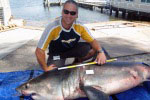
Mortality rates of sharks
As a follow-up to his PhD work, Wildlife Marine founder, Dr William Robbins,
collaborated with James Cook University colleagues to quantify the
differences found in shark population mortality models. Mortality estimates are
a vital parameter in determining demographic models, and this work will allow
future shark management plans to be based on quality-assured mathematical
models. This work is freely available from the Public Library of Science.





































